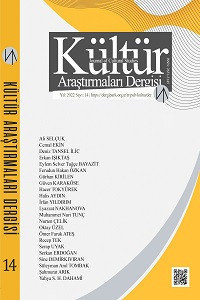"Dişileştirilmiş" Doğu'da Kadın: Şehrazat ile Peçe Duvarını Yıkmak
Şarkiyatçılık, Edward Said tarafından, kültürel farklılıkların Batı'yı Şark/Batı ikiliğiyle nasıl bir Doğu imajı inşa ettirdiği bağlamında resmedilir. Batı'nın Doğu algısını şekillendiren Doğu kültürünü, geleneğini ve dinini tasvir eden çok sayıda yazı ortaya çıktı. Bu yazılar sadece etnisite ve din etrafında değil aynı zamanda toplumsal cinsiyet etrafında da dönmüştür, dolayısıyla Doğu-Batı ikiliğinin dişil-eril ikiliği ile yan yana getirilmesine yol açmıştır. Bu dizilim, Doğu'nun baskın bir simgesi olan örtülü kadının, yani kadının toplumdaki yerine ilişkin en yaygın klişeyi gündeme getirmiştir. Bu bağlamda, Doğu'nun Batı tarafından “dişileştirildiği” söylenebilir. Batı ile Doğu arasındaki kültürel, politik ve dinsel bölünme tarafından başlatılan bu "dişileştirme", Şarkiyatçılık tarihinde Batılılar tarafından Doğulu kadınların ardı ardına yapılan tasvirleriyle derinleşti. Bu tasvirlerin mesajı “Doğu'da peçeli kadının nasıl "sessiz” tutulduğuna dikkat çeker. Yapılan tasvirlerden farklı olarak, bu sessizliği bozan ve Doğulu kadınlara ilham veren güçlü bir kadın vardır: Şehrazat. Şehrazat hikâyeleriyle erkekleri kendi cehaletlerini ve önyargılarını geride bırakmaya, kadının varlığını ve değerini tanımaya ve kadınları haklarını talep etmek için kendi peçelerini çıkarmaya teşvik etti. Bu yazıda amaç, Şehrazat'ın Binbir Gece Masalları'nda Doğulu kadınlara öykü anlatma sanatı yoluyla, kökleşmiş basmakalıplardan kurtulmak için mücadele etmeleri için nasıl ilham verdiğini keşfetmektir.
Anahtar Kelimeler:
Şehrazat, Binbir Gece Masalları, Şarkiyatçılık, kadın, Doğu
Woman in the “Feminized” East: Breaking the Wall of Veil with Scheherazade
Orientalism is portrayed by Edward Said within the context of how cultural differences have made the West construct an image of the East with the dichotomy of Orient/Occident. Numerous writings have been engendered depicting Eastern culture, tradition, and religion that shaped the West’s perceptions of the East. These writings have revolved around not only ethnicity and religion but also gender, hence leading to the juxtaposition of the dichotomy Orient-Occident with that of feminine-masculine. This alignment has brought forward the most common stereotype pertaining to the place of woman, in other words, the veiled woman which is a predominant symbol of the East. Thus, the East can be said to have been “feminized” by the West. Initiated by the cultural, political, and religious divide between the West and the East, this “feminization” was deepened by ongoing representations of Oriental women by Westerners in the history of Orientalism: how veiled woman has been kept “silence” in the East. Unlike these representations, there is a powerful woman who broke this silence and inspired Oriental women: Scheherazade. Through her stories, Scheherazade encouraged men to look past their own ignorance and biases, recognize the existence and value of women, and encourage women to remove their own veil to demand their rights. In this paper, the aim is to explore how Scheherazade in The Tales of One Thousand and One Nights (The Arabian Nights) inspirited Oriental women through the art of storytelling to fight for emancipation from the engrained stereotypes.
Keywords:
Scheherazade, The Tales of One Thousand and One Nights, Orientalism, woman, East,
___
- Bhabha, Homi (1952). “Foreword: Remembering Fanon: Self, Psyche and the Colonial Condition”. Black Skin, White Masks. London: Pluto Press.
- Burton Richard F. (trans.) (2002). The Book of the Thousand Nights and a Night. Oxford.
- Burton, Richard F. (1885). The Book of the Thousand Nights and a Night, Vol. 1. USA: The Burton Club.
- Gauch, Suzanne (2007). Liberating Shahrazad: Feminism, Postcolonialism and Islam. Minneapolis. MN: The University of Minnesota Press.
- Herath, Thisaranie (2016). “Women and Orientalism: 19th Century Representations of the Harem by European Female Travellers and Ottoman Women”. Constellations, 7/1(10): 31-40.
- Kahf, Mohja (2002). Western Representations of the Muslim Woman: From Termagant to Odalisque. Austin: University of Texas Press.
- Kiernan Victor G. (1972). The Lords of Human Kind: European Attitudes Towards Outside World in the Imperial Age. Harmondsworth: Serif.
- Lewis, Reina (1993). “Only Women Should Go to Turkey’ Henriette Browne and Women's Orientalism”. Third Text, 22: 53-64.
- Lewis, Reina (2004). Rethinking Orientalism: Women, Travel and the Ottoman Harem. New Brunswick: Rutgers University Press.
- Malti-Douglas, Fedwa (1997). “Introduction”. The Thousand and One Nights in Arabic Literature and Society. Eds. Richard G. Hovanissian & Georges Sabagh. Cambridge: Cambridge University Press.
- Mamet-Michalkiewicz, Marta (2011). Between the Orient and the Occident: Transformations of The Thousand and One Nights. Katowice: Wydawnictwo Uniwersytetu Śląskiego.
- McClintock, Anne (1994). “The Angel of Progress: Pitfalls of the Term Postcolonialism”. Colonial Discourse/Postcolonial Theory. Eds. Francis Barker et al. Manchester: Manchester University Press, 253-266.
- McLeod, John (2000). Beginning Postcolonialism. Manchester: Manchester University Press.
- Mernissi, Fatema (2001). Scheherazade Goes West: Different Cultures, Different Harems. New York: Washington Square Press.
- Mernissi, Fatima (1995). Dreams of Trespass: Tales of a Harem Girlhood. New York: Perseus Books.
- Said, Edward (1978). Orientalism. London: Penguin Books.
- Sevinc, Mine (2020). Shahrazad’s Storytelling as Postcolonial Feminine Writing in the Novels of Hanan al-Shaykh and Elif Shafak. PhD Thesis. Guildford: University of Surrey.
- URL-1: Schlote, Christiane, “An Interview with Hanan al-Shaykh”. www.literarylondon.org/london-journal/september2003/Schlote.html (Accessed on 2/1/2016).
- Weber, Charlotte (2001). “Unveiling Scheherazade: Feminist Orientalism in the International Alliance of Women, 1911-1950”. Feminist Studies, 27(1): 125–157.
- Willis, Peter (2011). “Scheherazade’s Secret: The Power of Stories and the Desire to Learn”. Australian Journal of Adult Learning, 51: 110-122.
- ISSN: 2651-3145
- Yayın Aralığı: Yılda 4 Sayı
- Başlangıç: 2018
- Yayıncı: Mehmet Ali YOLCU
